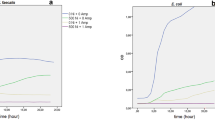Abstract—
The effect of 25Mg, a magnetic magnesium isotope, on the sensitivity of Escherichia coli K12 TG1 to quinolone/fluoroquinolone (nalidixic acid and ciprofloxacin) and aminoglycoside antibiotics (amikacin and tobramycin) was found. In the case of fluoroquinolones, determination of antibiotic sensitivity by the disc diffusion method revealed the 7‒14% larger growth inhibition zones on the medium with the magnetic magnesium isotope than for the same antibiotics in the variants with 24Mg, 26Mg, or the natural Mg isotope. The effect of the magnetic magnesium isotope 25Mg on the increase in resistance to the quinolones/fluoroquinolones group of antibiotics was observed independently of the determining method: the growth rate of E. coli culture incubated in the medium with 25Mg and ciprofloxacin decreased by 80% compared to the control without antibiotics, while in the variants with 24Mg, 26Mg, and natural Mg the decrease did not exceed 50%. An increase in antibiotic resistance (opposite magnetic isotopic effect) was shown for amikacin, tobramycin, and clindamycin. In the variants with amikacin and clindamycin, the growth inhibition zones of bacteria enriched with 25Mg were 16‒17 and 17‒24% smaller, respectively. An increase in resistance to tobramycin (aminoglycosides) was observed for submerged E. coli cultures growing in the medium with 25Mg: at the antibiotic concentration two times lower than the MIC, the growth rate of E. coli was 86% of the control, while in the variants with nonmagnetic isotopes or natural magnesium it decreased by 40‒50%. The mechanisms of magnetic isotopic effects of 25Mg are discussed: its effect on the enzymatic activity of Mg-dependent enzymes involved in protection of the cells from the action of antibiotics.
Similar content being viewed by others
REFERENCES
Andreini, C., Bertini, I., Cavallaro, G., Holliday, G.L., and Thornton, J.M., Metal ions in biological catalysis: from enzyme databases to general principles, J. Biol. Inorg. Chem., 2008, vol. 13, pp. 1205–1218.
Black, J.R., Yin, Q.Z., Rustad, J.R., and Casey, W.H., Magnesium isotopic equilibrium in chlorophylls, J. Am. Chem. Soc., 2007, vol. 129, pp. 8690‒8691.
Bowen, H.J.M., Biological fractionation of isotopes, Int. J. Appl. Radiat. & Isot., 1960, vol. 7, pp. 261‒272.
Bist, P. and Rao D.N., Identification and mutational analysis of Mg2+ binding site in EcoP15I DNA methyltransferase: involvement in target base eversion, J. Biol. Chem., 2003, vol. 278, pp. 41837‒41848.
Bock, A.K., Glasemacher, J., Schmidt, R., and Schönheit, P., Purification and characterization of two extremely thermostable enzymes, phosphate acetyltransferase and acetate kinase, from the hyperthermophilic eubacterium Thermotoga maritima,J. Bacteriol., 1999, vol. 181, pp. 1861‒1867.
Buchachenko, A.L., Magnetic Isotope Effect in Chemistry and Biochemistry, New York: Nova Science, 2009.
Buchachenko, A.L., Magneto-Biology and Medicine, New York: Nova Science, 2014.
Buchachenko, A.L., Bukhvostov, A., Ermakov, K., and Kuznetsov, D., Nuclear spin selectivity in enzymatic catalysis: A caution for applied biophysics, Arch. Biochem. Biophys., 2019, vol. 667, pp. 30–35.
Buchachenko, A.L., Kuznetsov, D.A., and Breslavskaya, N.N., Chemistry of enzymatic ATP synthesis: an insight through the isotope window, Chem. Rev., 2012, vol. 112, pp. 2042–2058.
Buchachenko, A.L., Orlov, A.P., Kuznetsov, D.A., and Breslavskaya, N.N., Magnetic isotope and magnetic field effects on the DNA synthesis, Nucl. Acids Res., 2013, vol. 41, pp. 8300–8307.
Fahad, Z.A., Bolou-Bi, E.B., Köhler, S.J., Finlay, R.D., and Mahmood, Sh., Fractionation and assimilation of Mg isotopes by fungi is species dependent, Environ. Microbiol. Rep., 2016, vol. 8, pp. 956–965.
Leclercq, R., Mechanisms of resistance to macrolides and lincosamides: nature of the resistance elements and their clinical implications, Antimicrob. Resist., 2002, vol. 34, pp. 482‒492.
Letuta, U.G. and Berdinskiy, V.L., Magnetosensitivity of bacteria E. coli: Magnetic isotope and magnetic field effects, Bioelectromagnetics, 2017, vol. 38, pp. 581‒591.
Letuta, U.G. and Tikhonova, T.A., Magnetic fields and magnetic isotope 25Mg effects on biofilms formation by bacteria E. coli,Doklady Biochem. Biophys., 2019, vol. 484, no. 1, pp. 85‒87.
Letuta, U.G., Berdinskiy, V.L., Udagawa, C., and Tanimoto, Y., Enzymatic mechanisms of biological magnetic sensitivity, Bioelectromagnetics, 2017, vol. 38, pp. 511‒521.
Li, Y., Green, K.D., Johnson, B.R., and Garneau-Tsodikova, S., Inhibition of aminoglycoside acetyltransferase resistance enzymes by metal salts, Antimicrob. Agents Chemother., 2015, vol. 59, pp. 4148‒4156.
Manual of Methods for General Bacteriology, Gerhardt, P., Murray, R.G.E., Costilow, R.N., Nester, E.W., Wood, W.A., Krieg, N.R., and Phillips, G.B., Eds., Washington: Amer. Soc. Microbiol., 1981.
Osburn, M.R., Dawson, K.S., Fogel, M.L., and Sessions, A.L., Fractionation of hydrogen isotopes by sulfate- and nitrate-reducing bacteria, Front. Microbiol., 2016, vol. 7, article 1166.
Ramirez, M.S., Nikolaidis, N., and Tolmasky, M.E., Rise and dissemination of aminoglycoside resistance: the AAC(6')-Ib paradigm, Front. Microbiol., 2013, vol. 4, article 121.
Ramirez, M.S. and Tolmasky, M.E., Amikacin: uses, resistance, and prospects for inhibition, Molecules, 2017, vol. 22, pp. 2267‒2290.
Semina, N.A., Determination of microbial sensitivity to antibacterial preparations, Klin. Mikrobiol. Antimikrob. Khimikoter., 2004, vol. 6, no. 4, pp. 306–359.
Shevchenko, U.G., Avdeeva, E.I., and Berdinskii, V.L., Biological effects of the 25Mg magnetic isotope in E. coli cells, Russ. J. Phys. Chem. B, 2012, vol. 6, no. 4, pp. 531‒537.
Shevchenko, U.G., Karandashev, V.K., Avdeeva, E.I., Berdinskii, V.L., and Alidzhanov, E.K., RF Patent no. 2499042, Bull. Izobret., no. 32. 20.11.2013.
Zhang, X., Gillespie, A.L., and Sessions, A.L., Large D/H variations in bacterial lipids reflect central metabolic pathways, Proc. Natl. Acad. Sci. U. S. A., 2009, vol. 106, pp. 12580–12586.
Funding
The work was supported by the Grant Council of the President of the Russian Federation, application SP-225.2019.4.
Author information
Authors and Affiliations
Corresponding author
Ethics declarations
The authors declare that they have no conflict of interest. This article does not contain any studies involving animals or human participants performed by any of the authors.
Additional information
Translated by P. Sigalevich
Rights and permissions
About this article
Cite this article
Letuta, U.G., Binder, A.S. & Tikhonova, T.A. Effect of Magnesium Isotopes on Antibiotic Sensitivity of E. coli. Microbiology 89, 273–277 (2020). https://doi.org/10.1134/S0026261720030091
Received:
Revised:
Accepted:
Published:
Issue Date:
DOI: https://doi.org/10.1134/S0026261720030091



